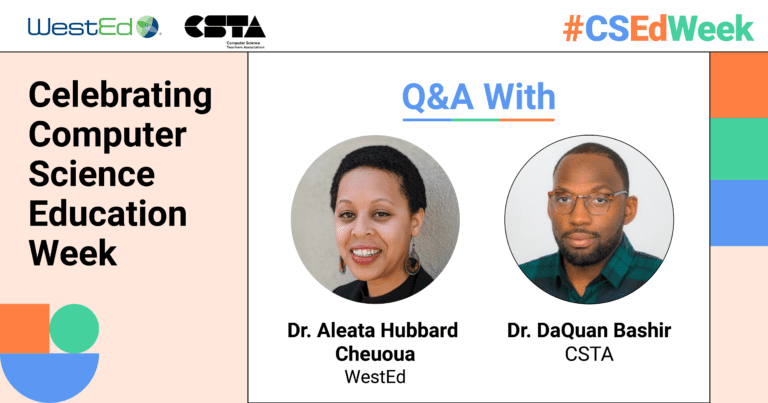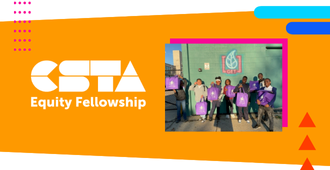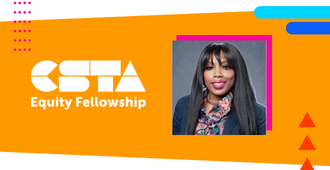By: CSTA Equity Fellow Cynthia Brawner
What if school districts across the globe did something radical in 2024? “What’s more radical than school districts’ attempt to close the now too wide learning gap?” you ask. Well, how about intentionality? Yes, being intentional in integrating CS in all classrooms, especially preschool and elementary levels. Not the intentional where we sometimes say when actually meaning, “I’ll try to remember the purpose for …” I mean ‘intentional’ at another level that’s not happening in all U.S. districts. I’m talking about computer science in every, EVERY classroom. No matter the subject, computer science has to have an intentional permanent spot. Not just a section where one says, “Oh darn! We didn’t have enough time for this lesson for computer science. Maybe the next lesson.” Intentional with computer science — treating it as the heartbeat of the work.
In an article by Edweek, “Only slightly more than half of U.S. schools offer computer science, and even fewer elementary and middle school do.” The latest data from the Nations Reportcard regarding the United States is: “The 2023 reading scores for age 13 students at all five selected percentile levels declined compared to 2020. The declines ranged from 3 to 4 points for middle- and higher-performing students to 6 to 7 points for lower-performing students, though the score declines of lower performers were not significantly different from those of their middle- and higher-performing peers.” Wow!
Let’s imagine students from preschool to high school having computer science as a significant asset to the pulse of their classroom: their ELA, math, science, social science, etc., classroom. Here’s another thought. What if all districts decided to implement CS into their non-computer science classrooms, the ones that mean well but actually dabble with CS by assuring students use the computer every now and then. Check it out…
There is research that many U.S. students performed lower in reading and math in the SY22-23 than in SY19-20 compared to same-aged students in other parts of the world. The New York Times article Math Scores Dropped Globally, but the U.S. Still Trails Other Countries, reported: “Just 7 percent of U.S. students scored at the highest levels in math, compared with 23 percent in Japan and South Korea, and 41 percent in Singapore, the top-performing country.”
Now districts, it appears, are scrambling to “restore the learning” or “lost learning,” as some refer to it. Let’s think about this for a moment. If something is being restored, it usually means bringing back to its previous version. If something is lost, that denotes trying to find it in its same condition and returning it to the owner. In a Harvard Magazine article, Post-COVID Learning Lossess, Congress passed an American Rescue Plan for pandemic relief funding that “amounted to $190-billion allocation for school districts to help students catch up.” The same article cites Tom Kane, director of the Center for Education Policy Research at the Graduate School of Education, stated that “there was little federal guidance” and “everyone was ‘left on their own’.” He is also quoted as stating in an interview that “‘…nobody knows how to help students catch up.’”
Well, prior to the early part of the COVID-19 era, according to a Washington Post article, U.S. students performed much lower in reading and math than children their age globally. So, why are we trying to “restore” or “find” the past learning? Let’s start something new this new year! Let’s intentionally incorporate CS into every subject area.
Computer science integration lends itself to many benefits. According to Microsoft’s education team, “An important part of building up students’ CS capabilities is to engage learners as early as possible, which encourages and supports creative expression and the development of computational thinking skills.” Let’s consider the “What if, then possibly” factor. The “What if, then possibly” factor is an imaginary platform allowing educators to take facts and envision realistic outcomes, leading to the possibility of making them happen.
What if districts put a heavy emphasis on computational thinking in the preschool grades? Then there is a strong possibility that as the students mature, they are successful in all subject areas.
What if apprehensive educators took the plunge to learn a bit more about CS and use strategies that required students to do more with age/grade-appropriate CS tasks. There is a possibility that students develop a hidden career talent.
What if projects like the science fair are captured digitally on slides and submitted for a grade?
What if the textbooks all had key parts in digital 3D formats? Then, many of the students may focus more on knowing more.
What if all teaching schedules had scheduled block times for CS in all classrooms?
It’s time for action in 2024. Do we really want to restore or find past learning habits? Let’s do something different. Let’s provide a platform that goes beyond helping students be successful but provides society with thinkers who can organize and problem-solve. Here’s a thought: do we really wait until a child is near adulthood to implement any skills with fidelity? Then why not incorporate computational thinking skills via computer science each day in elementary school, beginning with preschool?
I leave you with this quote from the Journal of Computer Science Integration:
“To be successful in a changing economy, students must learn to think algorithmically and computationally, to solve problems with varying levels of abstraction. These computational thinking skills have become so integrated into social function as to represent fundamental literacies. However, computer science is not widely taught in [PreK] K-12 US schools. Efforts to create computer science standards and frameworks have yet to make their way into mandated course requirements.”
Resources
Journal of Computer Science Integration
Washington Post articleNew York Times article Math Scores Dropped Globally, but the U.S. Still Trails Other Countries
About the Author

Cynthia Brawner is a National Board veteran teacher with over 25 years of experience. She teaches all subjects: English Language Arts, Math, Science, Social Studies, Writing, and coding to her third-graders at Wadsworth STEM Elementary in Chicago, Illinois. She runs the after-school Computer Science, Podcasting, Inventors, and Videography clubs for grades 3rd to 8th.
Cynthia’s educational mission: empower as many students as possible through academic exposure to help students have a voice and reach their full potential. She’s a PilotLight Food Education Fellow, a Field Museum Ambassador, a DonorsChoose Ambassador, A Scholastic SuperSTEM Advisor, a Museum of Science and Industry Teacher Initiative Partner, and a Global Schools Mentor. She holds several postgraduate degrees: an MA in Early Childhood Advocacy and an MS in School Administration. She also holds several certificates from Adobe Exchange Education, ISTE, and CSTA. She is active in the faith-based community and continues to enjoy teaching.




